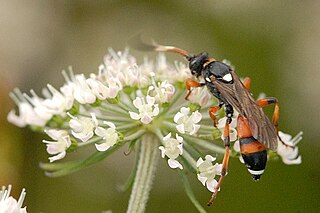
The ovipositor is a tube-like organ used by some animals, especially insects, for the laying of eggs. In insects, an ovipositor consists of a maximum of three pairs of appendages. The details and morphology of the ovipositor vary, but typically its form is adapted to functions such as preparing a place for the egg, transmitting the egg, and then placing it properly. For most insects, the organ is used merely to attach the egg to some surface, but for many parasitic species, it is a piercing organ as well.

The superfamily Ichneumonoidea contains one extinct and three extant families, including the two largest families within Hymenoptera: Ichneumonidae and Braconidae. The group is thought to contain as many as 100,000 species, many of which have not yet been described. Like other parasitoid wasps, they were long placed in the "Parasitica", variously considered as an infraorder or an unranked clade, now known to be paraphyletic.

The Ichneumonidae, also known as ichneumon wasps, ichneumonid wasps, ichneumonids, or Darwin wasps, are a family of parasitoid wasps of the insect order Hymenoptera. They are one of the most diverse groups within the Hymenoptera with roughly 25,000 species described as of 2016. However, this likely represents less than a quarter of their true richness as reliable estimates are lacking, along with much of the most basic knowledge about their ecology, distribution, and evolution. It is estimated that there are more species in this family than there are species of birds and mammals combined. Ichneumonid wasps, with very few exceptions, attack the immature stages of holometabolous insects and spiders, eventually killing their hosts. They thus fulfill an important role as regulators of insect populations, both in natural and semi-natural systems, making them promising agents for biological control.

Rhopalosomatidae is a family of Hymenoptera containing about 68 extant species in four genera that are found worldwide. Three fossil genera are known.

The Egyptian mongoose, also known as ichneumon, is a mongoose species native to the tropical and subtropical grasslands, savannas, and shrublands of Africa and around the Mediterranean Basin in North Africa, the Middle East and the Iberian Peninsula. Whether it is introduced or native to the Iberian Peninsula is in some doubt. Because of its widespread occurrence, it is listed as Least Concern on the IUCN Red List.

Megarhyssa, also known as giant ichneumonid wasps, giant ichneumons, or stump stabbers, is a genus of large ichneumon wasps, with some species known for having the longest ovipositors of any insects. They are idiobiont endoparasitoids of the larvae of wood-boring horntail wasps. The ovipositor can be mistaken for a large stinger. This is a genus of holometabolous insects within subfamily Rhyssinae that includes 37 species and belongs to Ichneumonidae, the family of wasps with the highest biodiversity in the world.

Cryptostylis, commonly known as tongue orchids, is a genus of flowering plants from the orchid family. Tongue orchids are terrestrial herbs with one to a few stalked leaves at the base of the flowering stem, or leafless. One to a few dull coloured flowers are borne on an erect flowering stem. The most conspicuous part of the flower is the labellum, compared to the much reduced sepals and petals. At least some species are pollinated by wasps when they attempt to mate with the flower. There are about twenty five species found in South Asia, Southeast Asia and the South Pacific.
In the 10th edition of Systema Naturae, Carl Linnaeus classified the arthropods, including insects, arachnids and crustaceans, among his class "Insecta". Insects with membranous wings, including bees, wasps and ants were brought together under the name Hymenoptera.
Labenopimplinae are an extinct subfamily of the parasitic wasp family Ichneumonidae. Labenopimplinae are known from the Cenomanian of the Russian Far East and Turonian of Orapa, Botswana. The subfamily includes five genera with 13 species. The subfamily is highly polymorphic and combines features of the Labeninae and Pimplinae.

Rhyssa persuasoria, also known as the sabre wasp, is a species belonging to the family Ichneumonidae subfamily Rhyssinae. Members of this subfamily, including those of Rhyssa and the allied Megarhyssa, are also known collectively as giant ichneumonid wasps or giant ichneumons.

Ichneumon is a genus of parasitoid wasps in the family Ichneumonidae.
Diadegma insulare is a wasp first described by Ezra Townsend Cresson in 1865. No subspecies are listed. It is a parasitoid of the diamondback moth, which is a pest of cruciferous crops.

Ichneumon sarcitorius is a species of wasp belonging to the family Ichneumonidae subfamily Ichneumoninae.
Ichneumon tottor is a species of wasp in the genus Ichneumon. It is endemic to South Africa.

Megarhyssa macrurus, also known as the long-tailed giant ichneumonid wasp or long-tailed giant ichneumon wasp, is a species of large ichneumon wasp. It is a parasitoid, notable for its extremely long ovipositor which it uses to deposit an egg into a tunnel in dead wood bored by its host, the larva of a similarly large species of horntail.
Ichneumon eumerus is a species of parasitic wasp belonging to the family Ichneumonidae, subfamily Ichneumoninae. It is a specialist parasite of the larva of the mountain Alcon blue butterfly.

Theronia is a genus of ichneumon wasps in the family Ichneumonidae. There are at least 30 described species in the genus Theronia. The genus has a worldwide distribution and includes species that are endoparasitoids or hyperparasitoids of Lepidoptera.
Abzaria is a genus of ichneumon wasps in the family Ichneumonidae. There are at least two described species in Abzaria.

Leptobatopsis is a genus of parasitic ichneumon wasp. Species of Leptobatopsis are diurnal.











